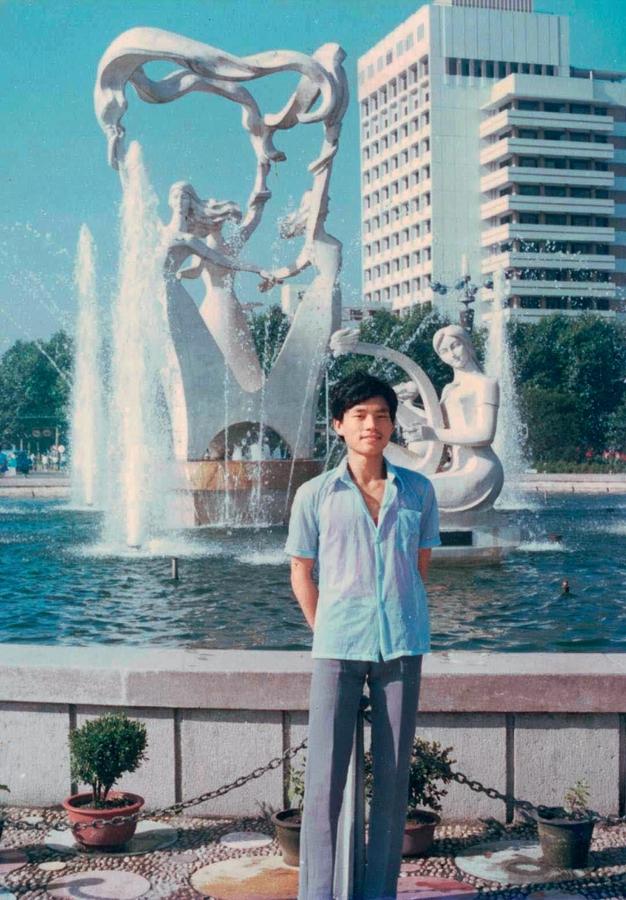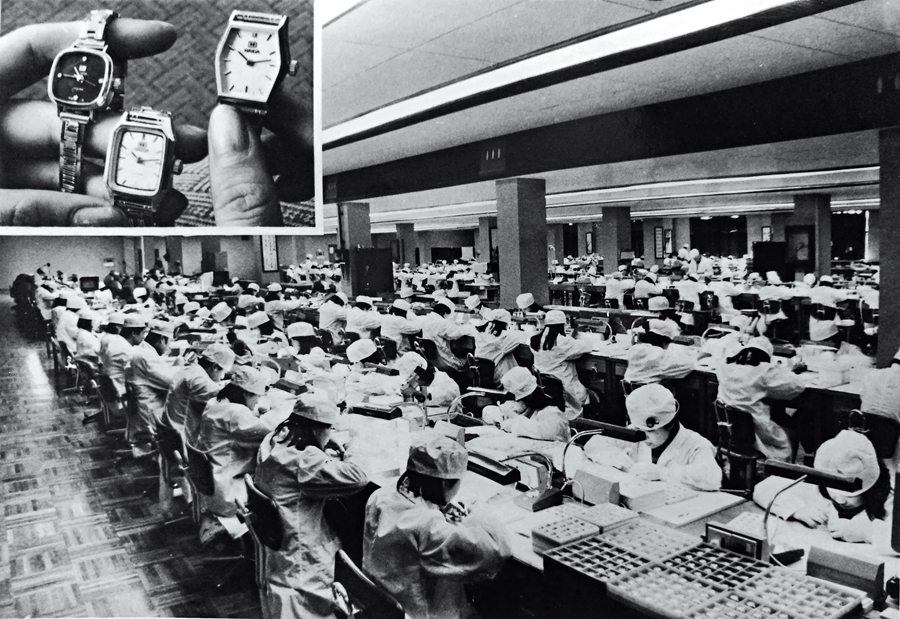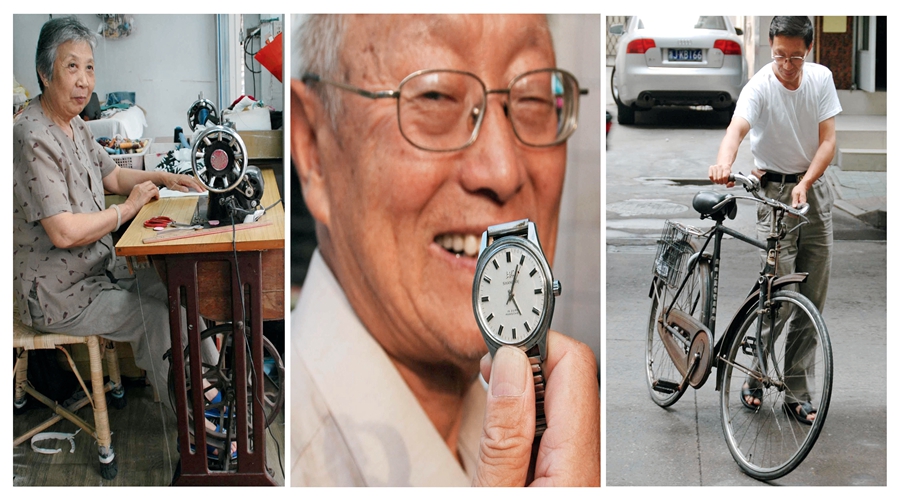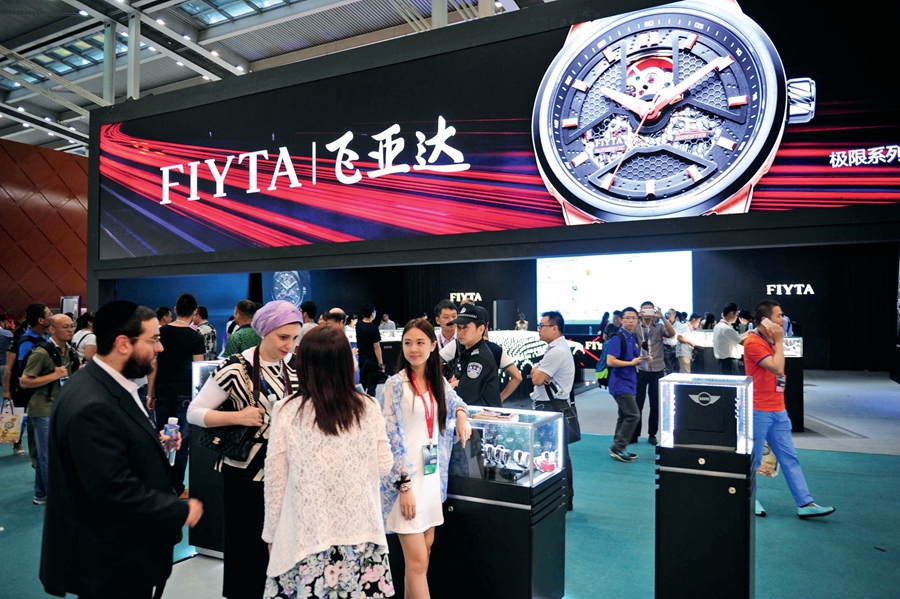By WANG ZHUSHENG
By WANG ZHUSHENG
JUST prior to the New Year, my son sent me a WeChat message, asking me what I wanted as a New Year gift. Since he had just started an entry-level position at his company, I knew he had little money for gifts. As such, I told him that I didn’t need any present this year. My reply seemed to disappoint him. To make him feel better, I told that if he really wanted to get me a gift, I would like a watch. A few days later, the watch was delivered and I loved it. It was very nice, and well over RMB 1,000. In that moment, I decided I would wear this watch forever.
My First Watch
Surely the main function of a watch is to indicate the time. But a watch can also display a person’s social status and wealth. These days, however, with the rise of smart phones, wearing a watch now seems almost unnecessary in daily life. For those who still wear one, the watch is mostly just an accessory, like a bracelet or a ring.

The author at Wulin Square, Hangzhou in June 1986.
Before the 1980s, watches were viewed as luxuries in China. A watch of a famous Chinese brand could cost RMB 120, equivalent to a three-month salary of an average worker. If it was imported from Switzerland, it would be much more expensive.
Some people even wore their watches in bed. In winter, they would roll up their sleeves to show off their wrist watches. When they wanted to know the time, they would intentionally swing their arm in an exaggerated manner to remind people that he or she had a watch.
Before I took my first college entrance exam in 1982, the teacher cautioned us to better manage our time during the test, and that was most easily achieved by wearing a watch. However, my impoverished family could not afford one, and none of my relatives had one. Seeing all my classmates with their watches on, I was overwhelmed with shame and disappointment. On an unrelated note, I failed the exam, but so did many of my watch-wearing classmates.
The next year, my mother, using almost all of her savings, bought me a watch worth RMB 30. Despite the large, unsightly face of the watch, I could tell the time anyway. I decided to take the college entrance exam again, this time wearing my new watch. However, thinking back to that test, I’m not sure whether I ever even checked the time.

The production plant of Shanghai No. 3 Watch Factory, photographed in 1986.
The first watch I bought myself was an electronic one. It cost me RMB 7. However, it was not waterproof. One rainy day, I returned home by riding a tractor with no roof. My electronic watch was soaked, and as I had expected, didn’t work anymore. My mother scolded me harshly for my foolish mistake. I was very dejected and hid under my blanket until I fell asleep, still wearing my broken, electronic watch. Due to the warmth of my body, the water evaporated and luckily, my watch started to work again! Despite this momentary success, it was short-lived, as the watch eventually failed to turn on and I knew there was no way to fix it. After I started work and finally made a decent salary, I bought multiple watches, most of which were pretty cheap. Then, like everyone else, I began to use the mobile phone which soon replaced my need for a watch.
A Treasured Object
The generation born in the 1950s and 60s have experienced the country’s tremendous changes under the reform and opening-up in a range of aspects, including politics, economy, education, culture, values, and lifestyle. The changing position of watch in their life reflects the country’s growth.

The three major items, consisting of a watch, a bike, and a sewing machine, were once a token of a happy life in the 1970s and early 80s in China.
I was born into a rural family. My parents earned a meager income to support the whole family. To pay their children’s tuition and books, they had to borrow money. In an era where many people couldn’t afford things like watches, wire broadcasting, which indicated each new hour, became people’s best way to keep track of time. Back then, rural Chinese people rarely made trips by bus or train, let alone plane. Therefore, there was no real reason for them to need to know the exact time; a rough calculation would be ok. Due to this, a watch was actually not a necessity for them, but despite this, they still longed to have one.
Back then, rural people who possessed a watch were those who had a job or enjoyed prestige in their regions. It was an era of planned economy, and almost all jobs were provided by the government or the state-owned sector. Rural people unanimously called those who worked for the government or the state-owned sector gongzuoren, meaning people who had a job. For those without money or a job, a watch costing more than RMB 100 was nothing more than a dream. If they saw someone who luckily owned one, most people could only express mixed feelings of admiration and envy. To make one’s fortune and be able to afford a watch and well-made clothes, rural children had to study hard and get accepted to college, and then they could become a gongzuoren. My parents drilled this into me to inspire me to study hard.
At that time, in both rural and urban areas, for newlyweds, a wrist watch, a bike, and a sewing machine were regarded as the most desired items one could have. In rural China, if a family could afford one or two out of the three items, the chances for their son to marry a girl were drastically higher. I remember in our village, there was a young man who became infatuated with a girl. The two were both into each other and later started to talk about marriage. However, the girl’s parents insisted the boy should buy the girl a watch. Failing to collect enough money to buy the watch, the young man had to end their relationship. This was not a rare case in rural areas.
In that era, people even created comical songs to express the importance of the three items. Feige, Yongjiu, and Fenghuang, once the most famous bike brands in China, together with the Hudie brand for sewing machines and Shanghai brand for watches, once represented the manufacturing level of China’s light industry. However, for the common people, these brands represented a luxury life.
Into the Future
As China’s reform and opening-up drive kicked off, people’s creativity that had been pent up for so long was suddenly unleashed. By the mid-1980s, the supply of watches had increased, with many brands appearing in rural shops. The former three major items for newlyweds had morphed into three new ones – a TV set, a refrigerator, and an air conditioner. With an increased average income and increased supply of goods, watches had become an ordinary object in people’s daily life. Thus, its role as a token of wealth diminished.

The Chinese watch brand FIYTA displays its products at an exhibition.
During the 1990s, a wide variety of watches became available for Chinese customers. Apart from the traditional mechanical watch, quartz and electronic watches quickly became the favorites among Chinese youth. By constantly introducing new models and features, the glittering watch advertisements on TV exposed consumers to a dazzling array of choices. Within a period of a decade or more, many big changes occurred in China. People couldn’t help but marvel at the great achievements of the country’s reform and opening-up and applaud the leadership’s wise decisions.
I once took a training session about how the details determine success or failure of China’s domestic watch industry. In the industry’s heyday, the Hangzhou-based watch brand Yingxiong, in order to improve its accuracy and rival with the Shanghai brand, invested a lot to import watch parts from Switzerland, which were assembled in its factory. The error of the brand’s watch decreased to 45 seconds from one minute, but still failed to meet their goal of 30 seconds. To fix this, the watch factory sent its technicians to Switzerland to study the watch-making process. It took them two months and US $1 million to finally find a solution: to achieve a high accuracy rate, before assembling the parts, they needed to be soaked in kerosene. By doing this, their watches’ accuracy improved by 50 percent.
Nowadays, the popularity of cell phones has further diminished the timing role of a watch in people’s life. With the advent of the Internet, big data, and AI, traditional industries have experienced the hardships of transformation and technological upgrading. Seemingly, smart phones are often viewed as the culprit strangling many traditional industries. Previously booming brands have now waned while new domestic watch brands are on the rise. Their exquisite watches are more like works of art, but still fail to impress consumers, nor are they able to compete with internationally famed luxury watch brands, which are still viewed as a symbol of wealth and social status.
Despite the minute differences between domestically produced watches and the world-renowned watch brands in terms of production technology and quality, their disparity in details decides their position in the market. In this sense, China’s watch industry still has a long way to go. I look forward to the day when international consumers will scramble to buy China-made watches as a token of their social status.
WANG ZHUSHENG is the general office director of Zhejiang Tianshi Nanotechnology Co., Ltd.